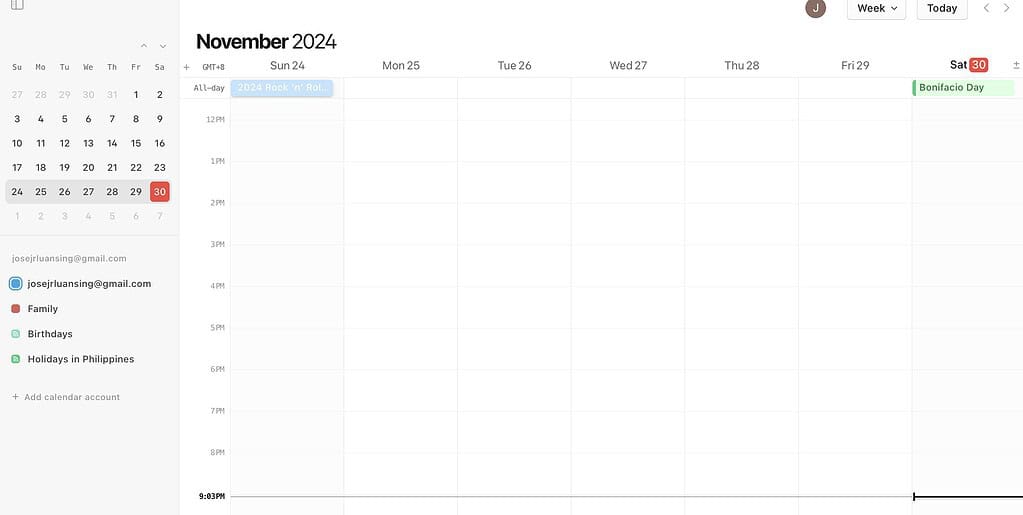Coming from a big family, I know the struggle of coordinating schedules across everyone’s calendar apps and tools. It feels like solving a Rubik’s Cube blindfolded. School drop-offs, social gatherings, work meetings—getting everyone on the same page is almost impossible. Miscommunication leads to missed appointments, overlapping plans, and, let’s be honest, unnecessary drama.
Instead of relying on post-it notes or endless group chats, streamline everything with one task management tool. Features like color-coded organization, event sharing, and cross-platform syncing can bring order to the chaos.
1. iCloud Calendar
Best for: Apple Ecosystem Users
Price: Free

iCloud Calendar feels like a natural choice if you’re already deep in the Apple ecosystem. It syncs with all your devices in real time. Whether you’re running with your Apple Watch or watching TikTok videos on your iPhone, you can access your schedule anywhere.
Another upside is its user-friendly interface. Apple products are known for their intuitive features, and the iCloud Calendar is no different. All your family members can easily create and share multiple items with just a few taps.
Calendar comes free with your Apple device. The only downside is it lacks advanced functionalities like task management or third-party app integrations.
2. Structured Daily Planner
Best for: Time-Blocking Enthusiasts
Price: Free; $2.99/month

Structured Daily Planner is the perfect tool for time-blocking. Its visually appealing timeline layout lets you map out your day hour by hour, making sure that no task slips through the cracks. Its features are also intuitive and easy to navigate.
The free version already offers all the essentials. And with a Pro upgrade, you’ll get unlimited tasks, iCloud sync, and themes. However, the app’s focus on daily planning might not work for broader weekly or monthly views.
3. ClickUp
Best for: Families with Complex To-Do Lists
Price: Free; Unlimited Plan at $7/user/month

ClickUp combines project management with calendar functionalities. Its calendar view integrates with the tasks, documents, and goals that you upload on the platform. You can also categorize them based on urgency and relevance. The entire system is very organized.
Upgrading to a premium plan gives you automation and advanced reporting tools, although I don’t see them being too useful outside the office. The free plan should suffice for most families. Like Notion, expect to invest some time and energy into learning the platform before you can wholly utilize it.
4. Notion Calendar
Best for: Multitaskers and Creative Planners
Price: Free; Personal Pro at $4/month

You probably first heard of Notion from your office’s project manager. While it might seem intimidating at first glance, its calendar features are much simpler to learn than you’d expect. Notion functions as an all-in-one workspace for notes, tasks, and projects. Its calendar lets you manage events while linking them to broader plans, daily to-do lists, and other custom templates.
The free version covers most essentials, and it’s already a solid choice for most families. If you need more, the Personal Pro plan unlocks advanced permissions and unlimited file uploads. Just take note of the steep learning curve. It’s more complex than your average calendar app, so prepare to invest some time before reaping its full potential.
5. Fantastical
Best for: Power Users Who Love a Clean Interface
Price: Free; Premium at $4.75/month (billed annually)

When an app calls itself “fantastic,” it has big expectations to meet. Luckily, Fantastical delivers. What makes it unique is its integration. You can sync it with project management tools, send out RSVP invites, set video calls, and even check weather forecasts for upcoming events. It aims to be a one-stop scheduling solution for families juggling multiple commitments.
However, the free version has significant limitations. You’ll need a premium plan to unlock collaborative scheduling, priority support, and advanced task management tools. Fantastical offers a two-week free trial, so you can test it out before committing.
6. BusyCal
Best for: Customization Enthusiasts
Price: $49.99 one-time purchase

BusyCal is a straightforward tool that gets the job done without unnecessary frills. Its minimalist interface is easy to navigate, and the intuitive features make managing tasks and events a breeze. But don’t mistake its simplicity for lack of functionality. You’ll still get smart filters, advanced search, and a built-in task manager to keep everything organized.
That said, the free version feels limited. You can upgrade to unlock weather forecasts, event countdowns, smart filters, graphics panels, and customizable calendar sets. One downside is that the interface can feel a bit dated compared to sleeker, more modern apps. If design matters to you, try exploring other options.
7. Microsoft Outlook
Best for: All-in-One Email and Calendar Management
Price: Free; Microsoft 365 plans start at $19.99/year

Yes, Outlook isn’t just for emails. It’s also a robust calendar tool that integrates seamlessly with Microsoft Office apps. If you’re already using Microsoft 365, you’ll have no problem incorporating this calendar tool into your daily life. Features like the Scheduling Assistant and shared calendar capabilities will make it easier to collaborate with colleagues and family members alike.
That said, Outlook’s interface can feel overwhelming for non-corporate users. I’d recommend it primarily for those already familiar with Microsoft’s ecosystem. Otherwise, you might benefit from a less complex app.
If you’re still on the fence, the built-in Calendar app is a great starting point. It’s simple, reliable, and effective. However, if your Mac and iPhone Calendar apps aren’t syncing, you can try to troubleshoot your iCloud account.
